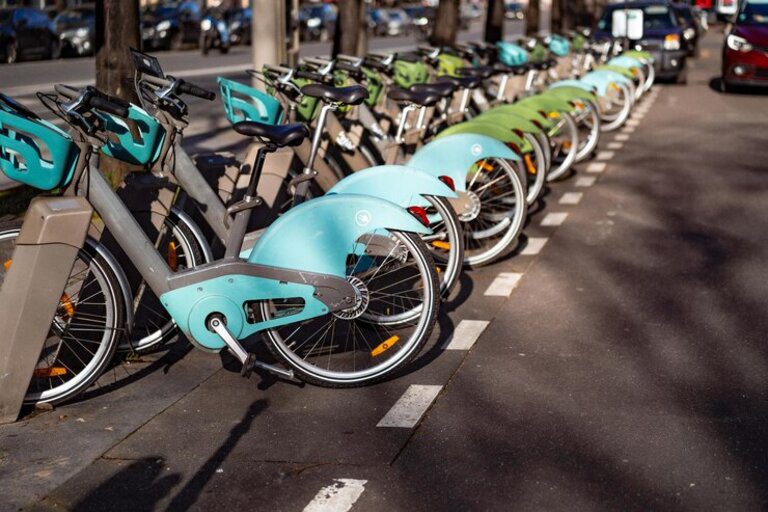E-Bikes On The Rise Are They As Safe As Regular Bikes Modern technology, growing environmental consciousness, and the desire for easier and more environmentally friendly forms of transportation have all contributed to the recent rise in popularity of e-bikes. Electric bikes are now commonplace in most places worldwide, both for individual ownership and for sharing and renting.For instance, sales and imports of e-bikes in Australia have nearly tripled since 2020. The trend toward electric-assisted cycling has become so significant that in Germany, e-bikes now make up more than half of all bike purchases.Read More About Latest Technology Visit https://imminentworld.com/
E-bikes are here to stay as the trend keeps growing. It is evident that e-bikes, which have battery-powered motors that help the rider, are a good substitute for driving, especially for short distances, and as a means of lowering carbon emissions and traffic jams. However, even as e-bikes gain popularity, there are still significant concerns regarding their safety, especially in comparison to conventional bicycles. Although there are no hard statistics as of now for the number of e-bike-related injuries and fatalities in Australia, global studies and trends provide insights into the type of safety concerns.
What International Data Tells Us:
One of the best datasets regarding cycling-related injuries and fatalities is available from the Netherlands, a country that boasts extensive cycling infrastructure and a high volume of bike riders. Therefore, it forms an important case for researchers to analyze the safety of e-bikes.
According to data gathered in the Netherlands since 2000, cycling-related deaths have stayed largely constant for nearly 20 years. But since 2018, things have started to change. The number of cyclist deaths hit a record high of 291 in 2022, which was about 25% more than the previous record established in 2000. The sharp rise in e-bike adoption is correlated with an increase in cyclist fatalities. Whereas normal bike owners decreased, the number of Dutch e-bike owners increased from 2.2 million in 2018 to 3.1 million in 2021.

Are E-Bikes More Deadly?
Even as the number of cycling crashes increases, while data from the Netherlands shows more accidents are associated with regular bikes, this may well be due to the simple reason that there are more regular bikes on the roads. However, when data are adjusted to the number of e-bikes as opposed to regular bikes, along with distance cycled, an apparent pattern emerges: death is much more likely among the riders of the e-bike.
This is not a unique trend in the Netherlands. The trend can be compared with data from Guangzhou, China. Between 2011 and 2021, incidents involving accidents and fatalities per 100,000 people increased for e-bikes, while accidents on regular bikes decreased. Deaths caused by e-bikes in Guangzhou have been escalating since 2018, where deaths associated with regular bikes have leveled off.
What About Injuries?
Non-fatal risks apply to cycling and e-bike riding as well. The injuries from accidents due to e-bikes are researched through the analyses of hospital databases. One clinic study conducted from 2010 to 2015 at the Swiss trauma center found that patients who used an e-bike had a greater number of higher severity traumatic head injuries than bicycle users. Similarly, data from Israel’s National Trauma Registry between 2013 and 2017 showed a dramatic increase in hospitalizations related to e-bike injuries, while those linked to regular bikes decreased. E-bike riders were also at greater risk of head injuries compared to regular cyclists.
However, another clinical study is seen to assert that the nature of injury severity among e-bike and regular bicycle users may not differ much after all. As seen in a Dutch study which established that traumatic brain injuries neither in frequency nor severity were associated with e-bike and normal bike riders.
So, Are E-Bikes More Unsafe?
While some research may indicate differences in injury pattern, there are certain trends that become clear. There is a propensity for e-bike riders to be injured on their spine and lower extremities: hips, legs, ankles, and feet, compared with conventional cyclists. E-bike riders are also more likely to be admitted into wards or ICU and have a higher probability of receiving surgical interventions as well as suffering fatalities from such injuries.
Why Do E-Bikes Have Greater Risks?
There is no single answer but multiple factors contribute to the higher risks associated with e-bikes. Speed is one of the most significant. E-bikes allow riders to reach higher speeds with less effort-on average, 13.3 km/h compared with 10.4 km/h for regular cyclists-and this increased speed can lead to more serious accidents.
Additionally, e-bike riders are often older and less experienced cyclists. This combination of speed, potential physical limitations, and the heavier weight of e-bikes increases the risk of crashes and injuries. For example, in the Swiss study mentioned earlier, injured e-bike riders admitted to the hospital were significantly older than regular cyclists. Data from the Netherlands also shows that e-bike fatalities tend to increase with age, especially among riders aged 60 and older.
Risk taking is yet another possible contributory factor. Riders of e-bikes could have a likelihood of engaging in riskier practice than regular bicyclists-for instance, lack of helmets or following traffic, riding under intoxication by alcohol among others. It is too soon for us to have a clue yet if e-bikers are engaging in such risks than other cyclists. What we do know is that riders of shared e-bikes are often less likely to wear helmets compared to those on their own bikes. This could be due to concerns about hygiene when using shared helmets.
What Needs to Change?
In order to make e-bikes safer for riders, pedestrians, and other road users in Australia, two significant adjustments are required as their use grows:
1.Establishing a National Registry:
Australia requires a national registry that will manage injuries and fatalities associated with e-bikes. Without a central system to collect the statistics, policymakers have to be dependent on data internationally which may not apply to the scenario in Australia.
2.Tailored Regulations:
Regulations need to be put in place in addressing specific risks of e-bikes. For example, increased helmet usage through strict enforcement, speed limits, and better regulation of shared services, to ensure availability and maintenance of helmets, among others.
E-bikes are here to stay. There is no doubt that e-bikes offer many benefits. However, it also comes with certain unique risks. Increasing awareness about these risks as their popularity increases is essential, enabling us to make e-bikes a safer mode of transportation for all while making them more sustainable.
Ultimately, e-bikes can continue to be a dependable and safe substitute for conventional cycling and driving if the risks are recognized and safety measures are taken, like as wearing a helmet and abiding by traffic regulations.

